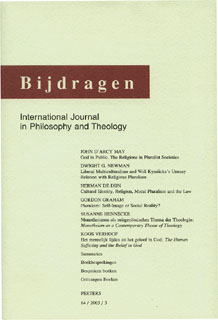 previous article in this issue previous article in this issue | next article in this issue  |

|
Document Details : Title: Gadamers Verständnis und Missverständins von Schleiermacher Author(s): VEDDER, Ben Journal: Bijdragen Volume: 64 Issue: 4 Date: 2003 Pages: 400-420 DOI: 10.2143/BIJ.64.4.503584 Abstract : The leading question of this article is the way Gadamer interpreted Schleiermacher. Already in Truth and Method Gadamer interpreted Schleiermacher trough the eyes of Dilthey. This resulted in the idea that Schleiermacher was interested in restoring the original meaning of a text. Gadamer never abandoned this psychological interpretation of Schleiermacher. This is a result from the fact that Gadamer did not involve Schleiermacher’s dialectic in his hermeneutics. Because of this Gadamer never mentioned the kinship between Schleiermacher and his own theory of interpretation. In Schleiermacher dialectic and hermeneutics are connected in the same way text constitution and text interpretation are connected. The art of speaking and of understanding are joined together in such a way that they imply each other. They are linked to each other like speaking (dialectic) and hearing (hermeneutics). This means that a text is always the result of both. The other, the reader, the interpreter is already there in the constitution of the text. Schleiermacher writes, as a predecessor of Gadamer, in his Dialektik “The more a text is dialogic, the more complete it is” (D. 53-54). In this way constitution and interpretation of a text are dependent on each other. By emphasizing the dialogical structure of our knowledge, Schleiermacher opens the way to a broader insight into the world. Through dialogue we can go beyond the limits of our selves and attain a relative universality. We learn to see things from different points of view. We can find traces of this in Gadamer’s hermeneutics, but Gadamer was not able to see that. |
